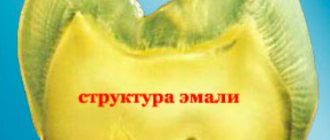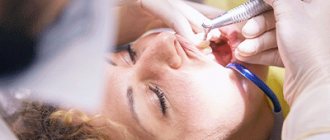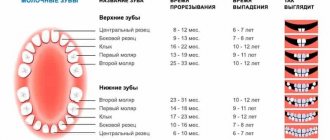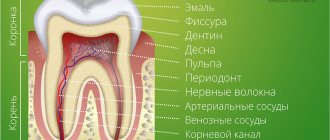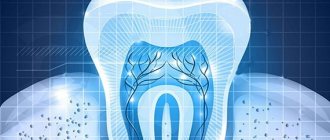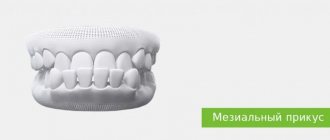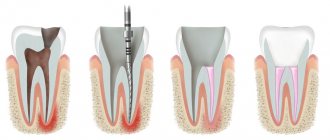The structure of the periodontium.
Fixation of the tooth, as noted, is carried out using periodontal tissue, the fibers of which are stretched between the cement and the bone alveolus. The combination of three elements (osseous dental alveolus, periodontium and cementum) is designated as the supporting apparatus of the tooth. The width of the periodontal fissure ranges from 0.1 to 0.55 mm. The direction of the bundles of collagen fibers of the periodontium is not the same in its various parts. At the mouth of the dental alveolus (marginal periodontium) in the retaining apparatus, dentogingival, interdental and dentoalveolar groups of fiber bundles can be distinguished (Fig. 1-48).
Rice. 1-48. Periodontal fibers : 1 - interpapillary; 2 - circular; 3 - interdental; 4 - dentogingival
Dental fibers begin from the cementum of the root at the bottom of the gingival pocket and spread fan-shaped outward into the connective tissue of the gums. The thickness of the beams does not exceed 0.1 mm.
Interdental fibers form powerful bundles 1.0-1.5 mm wide. They extend from the cementum of the contact surface of one tooth through the interdental septum to the cementum of the adjacent tooth. This group of bundles maintains the continuity of the dentition and participates in the distribution of chewing pressure within the dental arch. Dentoalveolar fibers start from the cementum of the root along the entire length and go to the wall of the dental alveolus. Bundles of fibers begin at the apex of the root, spread almost vertically, in the apical part - horizontally, in the middle and upper third of the root they go obliquely from bottom to top (see Fig. 1-48). The orientation of bundles of periodontal collagen fibers, as well as the structure of the spongy substance of the jaws, is formed under the influence of functional load. In teeth devoid of antagonists, over time the direction of the periodontal bundles from oblique becomes horizontal and even oblique in the opposite direction. The periodontium of non-functioning teeth is more loose.
Tooth surfaces.
For the convenience of describing the relief or localization of pathological processes, a conventional designation of the surfaces of the tooth crown has been adopted. There are five such surfaces (Fig. 1-49).
Rice. 1-49. Surfaces (a), edge (b) and axis (c) of the tooth
1. The closure surface faces the teeth of the opposite jaw. They are found in molars and premolars. These surfaces are also called chewing surfaces. The incisors and canines at the ends facing the antagonists have a cutting edge.
2. The vestibular (facial) surface is oriented towards the vestibule of the oral cavity. In the front teeth, in contact with the lips, this surface can be called labial, and in the back teeth, adjacent to the cheek, - buccal. The continuation of the tooth surface to the root is designated as the vestibular surface of the root, and the wall of the dental alveolus, covering the root from the vestibule of the mouth, is designated as the vestibular wall of the alveolus.
3. The lingual surface faces the oral cavity towards the tongue. For the upper teeth, the name palatal surface is applicable. The surfaces of the root and walls of the alveoli directed into the oral cavity are also called. 4. The contact surface is adjacent to the adjacent tooth. There are two such surfaces: the medial surface, facing the middle of the dental arch, and the distal one. Similar terms are used to refer to the roots of teeth and the corresponding parts of the alveoli. denoting directions in relation to the tooth are also common When examining and describing teeth, the following terms are used: vestibular norm, chewing norm, lingual norm, etc. The norm is the position established during the study. For example, the vestibular norm is the position of the tooth in which its vestibular surface faces the researcher. The crown and root of the tooth are usually divided into thirds. Thus, when dividing a tooth by horizontal planes, the occlusal, middle and cervical thirds are distinguished in the crown, and the cervical, middle and apical thirds in the root. The sagittal planes divide the crown into the medial, middle and distal thirds, and the frontal planes into the vestibular, middle and lingual thirds. The dental system as a whole . The protruding parts of the teeth (crowns) are located in the jaws, forming dental arches (or rows) - upper and lower. Both dental arches contain 16 teeth in adults: 4 incisors, 2 canines, 4 small molars, or premolars, and 6 large molars, or molars. When the jaws are closed, the teeth of the upper and lower dental arches are in certain relationships with each other. Thus, the cusps of the molars and premolars of one jaw correspond to the depressions on the teeth of the same name in the other jaw. In a certain order, opposite incisors and canines come into contact with one another. This ratio of the closed teeth of both dentitions is referred to as occlusion. The contacting teeth of the upper and lower jaws are called antagonist teeth. As a rule, each tooth has two antagonists - the main and additional ones. The exceptions are the medial lower incisor and the 3rd upper molar, which usually have one antagonist each.
Jaw bones
The upper jaw bone (maxilla) is a bone consisting of two symmetrical parts. Each part consists of a body and several processes: alveolar (it contains alveoli, “cells” in which the roots of teeth are located), zygomatic, frontal and palatine.
The palatine processes of both parts of the bone connect and form the palate. Also, the maxillary sinus is located in the bone of the upper jaw. Its bottom is located very close to the roots of the tooth, and the bottom bone is small in thickness, which creates certain difficulties during dental implantation.
The upper jaw is connected to the other bones of the skull without moving. This bone is light and thin, as it mainly consists of spongy bone tissue. Only the thin outer layer of bone consists of denser and stronger cortical bone tissue. The lower jaw bone (mandibula), through the temporomandibular joint, is movably connected to the bones of the skull.
The mandibular bone is more massive and durable, its cortical layer is thicker, since the masticatory muscles are attached to the lower jaw and bear the heaviest load.
The mandibular bone has a horseshoe-shaped body, an alveolar part with alveoli for the roots of the teeth, and two branches extending from the body at an angle. Each branch is divided into two processes: articular and coronoid. The alveolar “cells” of both the upper and lower jaws are lined inside with connective tissue - periodontium. Thanks to this tissue, the tooth root is securely fixed in the alveolus.
Dental formula.
The order of the teeth is recorded in the form of a dental formula, in which individual teeth or groups of teeth are written in numbers or letters and numbers. The complete dental formula is constructed in such a way that the teeth of each half of the jaws are written in Arabic numerals. This formula for an adult is as follows:
Individual primary teeth are indicated in the same way. The order of recording teeth in this formula is as if the recorder is examining the teeth of the person sitting in front of him, which is why this formula is called clinical. When examining patients, clinicians note missing teeth and circle the numbers of the teeth that require treatment. If all the teeth in a row are preserved, such a row is called complete.
The World Health Organization (WHO) has adopted a complete clinical dental formula for permanent dentition in a different form:
According to the WHO classification, the complete clinical dental formula for primary dentition is written as follows:
There are group dental formulas that reflect the number of teeth in each group in the halves of the jaws. This formula is called anatomical. In an adult, the group dental formula looks like this:
Signs of teeth.
The teeth of the same name in the right and left dental arches differ in their structure. There are three signs by which you can determine whether a tooth belongs to the right or left dental arch: 1) sign of the crown angle; 2) a sign of curvature of the crown enamel; 3) root sign. The sign of the crown angle is that in the vestibular norm the angle formed by the closure surface and the medial surface is sharper than the angle between the closure surface and the lateral surface of the cutting edge. The last corner is slightly rounded.
The sign of curvature of the crown enamel is determined by examining the tooth from the side of the closure surface (in the chewing norm), while the medial part of the crown enamel on the vestibular side is more convex than the distal one. The root sign is determined in the position of the tooth in the vestibular norm. If you draw the longitudinal axis of the crown (lower the perpendicular from the middle of the cutting edge) and the longitudinal axis of the tooth (from the apex of the root to the middle of the cutting edge), it turns out that the axis of the tooth is deviated laterally. Consequently, the direction of deviation of the longitudinal axis of the tooth indicates the side of the tooth (Fig. 1-50).
Rice. 1-50. Signs of crown angle and root position
Teeth
Normally, a person has from 28 to 32 teeth. Why from 28 to 32? Because the so-called “wisdom teeth” erupt late, some may not erupt at all, or collapse after eruption, so their absence is considered normal.
In a person’s entire life, they change their teeth only once—from baby teeth (temporary) to molars (permanent). At the same time, both milk and molars are formed during intrauterine development.
Already at 6-7 weeks of pregnancy, the embryo begins to form a dental plate with the rudiments of milk teeth. There are 20 rudiments in total - 10 at the bottom and at the top. In the third month of development, cells of pulp, dentin and enamel are formed, and from the 4th month the tissues themselves are formed. Dental cement is formed already at 4-5 months of a child’s life.
During intrauterine development, the formation of molars also occurs - this occurs around the 5th month. The rudiments of molar teeth are located behind the rudiments of milk teeth.
The eruption of baby teeth begins 4-7 months after birth. When a baby tooth erupts, the formation of dentin and enamel begins in the molar tooth bud. The molar develops, grows, its enamel presses on the root of the baby tooth, which ultimately leads to resorption of the root. As a result, the baby tooth falls out, and a molar erupts in its place. Temporary teeth begin to be replaced by molars at 6-7 years of a child’s life, and this process ends, on average, at 14 years. The very last teeth to erupt are the third molars. These teeth can erupt at the age of 20.
Tooth structure
Any tooth is conventionally divided into three parts: the root, the neck of the tooth and the crown of the tooth. The root of the tooth is located in the alveolus of the jaw bone. The root is attached to the alveolus of the jaw bone by means of periodontal collagen fibers.
The neck of a tooth is a small area, the transition from the root to the crown.
The crown is the part of the tooth that protrudes above the surface of the gum.
The inside of the tooth is not solid - the dentin forms a cavity, identical in shape to the shape of the tooth. This cavity is filled with pulp. Conventionally, the coronal part of the cavity and the root canals are divided. The canals are through - in the region of the root apex they end at the apical foramen. It is clear that the number of canals of a tooth is equal to the number of its roots.
If we look at the tooth layer by layer, we will see:
- Pellicle. The topmost, thinnest layer. This is an organic film that covers the enamel and protects it from destruction.
- Enamel. This is a layer of hard, durable, smooth substance that covers the crown and neck of the tooth. The chewing surface of the tooth has the thickest layer of enamel, and the neck of the tooth has the thinnest. Enamel has a complex composition, which has not yet been reproduced today. Despite the fact that enamel is the hardest tissue in our body, it is easily attacked by acids and destroyed.
- Cement. This is the tissue that covers the root of the tooth and performs the same functions as enamel. In addition, cement provides reliable attachment of the tooth root to the periodontium. The cement is saturated with minerals and permeated with collagen fibers, due to which the tooth is attached to the periodontium.
- Dentine. This is the main tissue of the tooth, which is similar in structure to bone tissue, but only stronger, due to greater mineralization.
- Pulp. This is loose connective tissue. It fills the entire tooth cavity, both its coronal part and the root canals. The pulp contains blood vessels, lymphatic vessels, and nerves.
Classification of teeth
Teeth are classified according to many criteria:
- By lifespan: dairy and indigenous.
- By function: incisors, canines, premolars, molars. Premolars are also called small molars, and molars are called large molars.
- By the number of roots: single-rooted, double-rooted, triple-rooted. Single-rooted teeth include incisors, canines, and premolars; double-rooted teeth include molars of the lower jaw; three-rooted teeth include molars of the upper jaw.
- According to the shape of the crown (by the number of tubercles): single-tubercle, double-tubercle, multi-tubercle. Single-tubercles include canines and incisors, double-tubercles include premolars, and multi-tubercles include molars.
All teeth, regardless of type and type, are equally susceptible to various diseases and damage that can lead to tooth loss. Therefore, reducing factors such as poor nutrition, poor oral hygiene, abuse of certain pharmaceuticals, bad habits and increased trauma, and avoiding dental treatment will be the best guarantee of teeth preservation at any age.
Read more...
Return to news list Frequently asked questions about implantation

